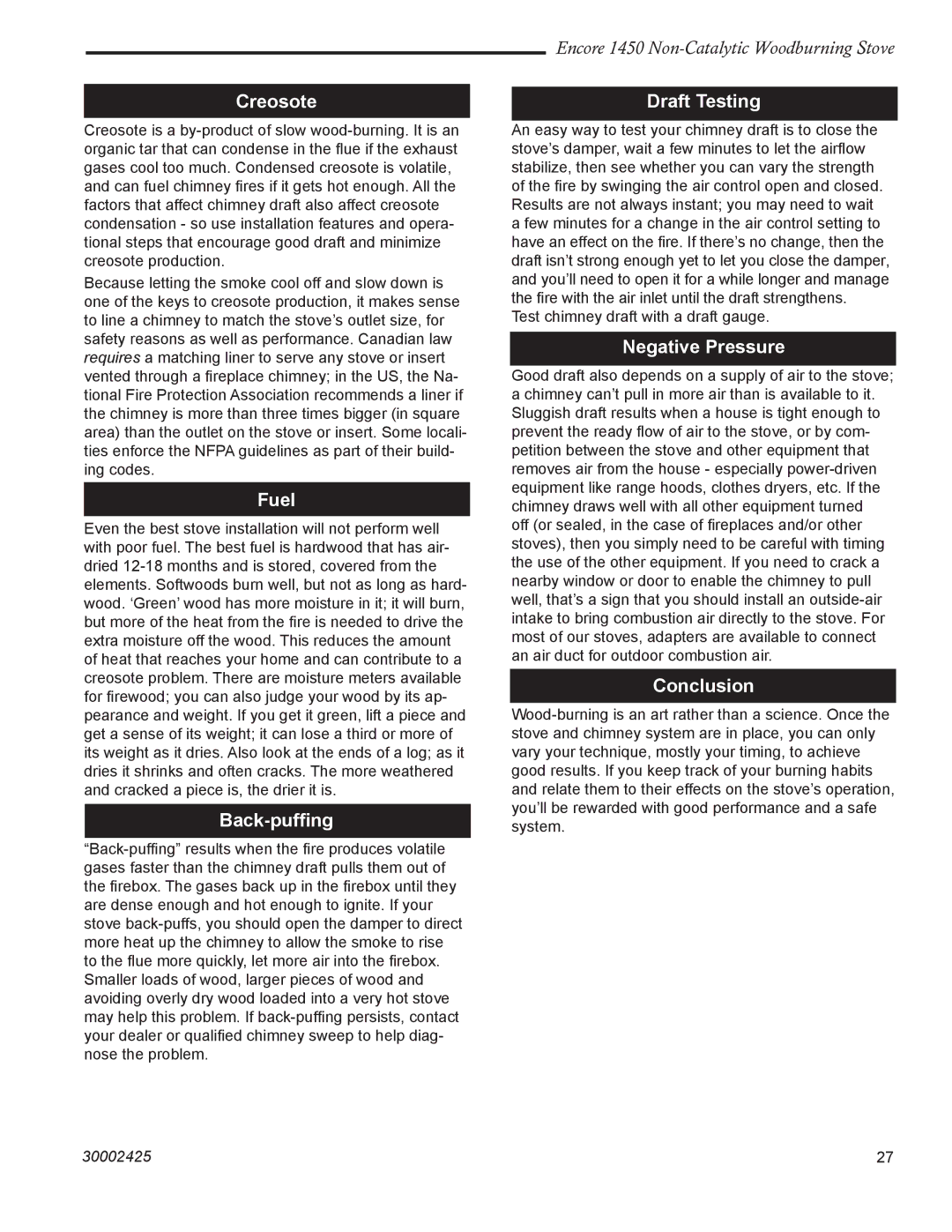Creosote
Creosote is a by-product of slow wood-burning. It is an organic tar that can condense in the flue if the exhaust gases cool too much. Condensed creosote is volatile, and can fuel chimney fires if it gets hot enough. All the factors that affect chimney draft also affect creosote condensation - so use installation features and opera- tional steps that encourage good draft and minimize creosote production.
Because letting the smoke cool off and slow down is one of the keys to creosote production, it makes sense to line a chimney to match the stove’s outlet size, for safety reasons as well as performance. Canadian law requires a matching liner to serve any stove or insert vented through a fireplace chimney; in the US, the Na- tional Fire Protection Association recommends a liner if the chimney is more than three times bigger (in square area) than the outlet on the stove or insert. Some locali- ties enforce the NFPA guidelines as part of their build- ing codes.
Fuel
Even the best stove installation will not perform well with poor fuel. The best fuel is hardwood that has air- dried 12-18 months and is stored, covered from the elements. Softwoods burn well, but not as long as hard- wood. ‘Green’ wood has more moisture in it; it will burn, but more of the heat from the fire is needed to drive the extra moisture off the wood. This reduces the amount of heat that reaches your home and can contribute to a creosote problem. There are moisture meters available for firewood; you can also judge your wood by its ap- pearance and weight. If you get it green, lift a piece and get a sense of its weight; it can lose a third or more of its weight as it dries. Also look at the ends of a log; as it dries it shrinks and often cracks. The more weathered and cracked a piece is, the drier it is.
Back-puffing
“Back-puffing” results when the fire produces volatile gases faster than the chimney draft pulls them out of the firebox. The gases back up in the firebox until they are dense enough and hot enough to ignite. If your stove back-puffs, you should open the damper to direct more heat up the chimney to allow the smoke to rise to the flue more quickly, let more air into the firebox. Smaller loads of wood, larger pieces of wood and avoiding overly dry wood loaded into a very hot stove may help this problem. If back-puffing persists, contact your dealer or qualified chimney sweep to help diag- nose the problem.
Encore 1450 Non-Catalytic Woodburning Stove
Draft Testing
An easy way to test your chimney draft is to close the stove’s damper, wait a few minutes to let the airflow stabilize, then see whether you can vary the strength of the fire by swinging the air control open and closed. Results are not always instant; you may need to wait a few minutes for a change in the air control setting to have an effect on the fire. If there’s no change, then the draft isn’t strong enough yet to let you close the damper, and you’ll need to open it for a while longer and manage the fire with the air inlet until the draft strengthens.
Test chimney draft with a draft gauge.
Negative Pressure
Good draft also depends on a supply of air to the stove; a chimney can’t pull in more air than is available to it. Sluggish draft results when a house is tight enough to prevent the ready flow of air to the stove, or by com- petition between the stove and other equipment that removes air from the house - especially power-driven equipment like range hoods, clothes dryers, etc. If the chimney draws well with all other equipment turned off (or sealed, in the case of fireplaces and/or other stoves), then you simply need to be careful with timing the use of the other equipment. If you need to crack a nearby window or door to enable the chimney to pull well, that’s a sign that you should install an outside-air intake to bring combustion air directly to the stove. For most of our stoves, adapters are available to connect an air duct for outdoor combustion air.
Conclusion
Wood-burning is an art rather than a science. Once the stove and chimney system are in place, you can only vary your technique, mostly your timing, to achieve good results. If you keep track of your burning habits and relate them to their effects on the stove’s operation, you’ll be rewarded with good performance and a safe system.

